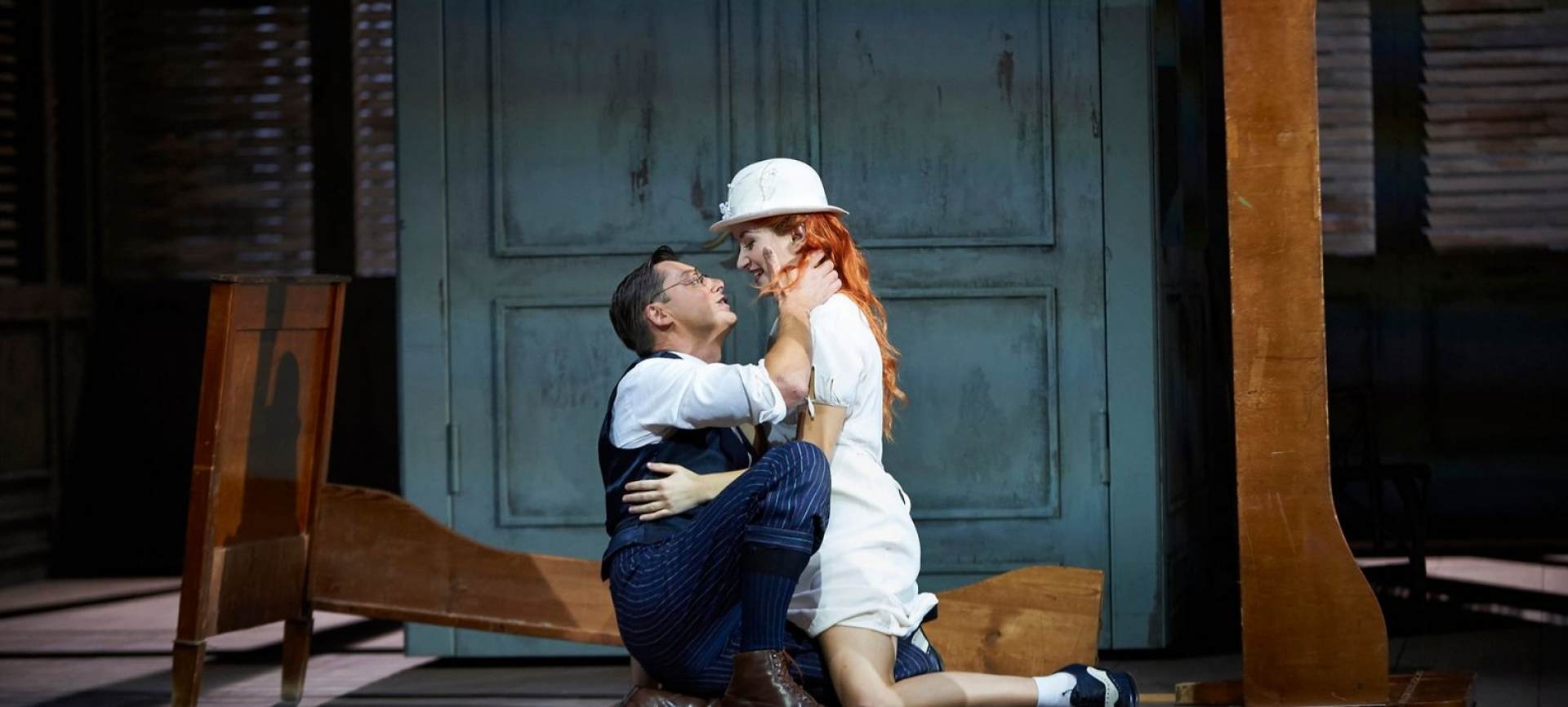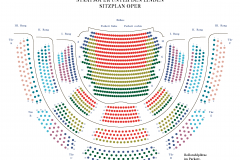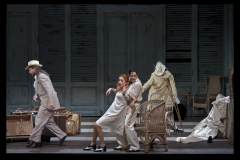The Marriage of Figaro
Mo | Tu | We | Th | Fr | Sa | Su |
COMMEDIA PER MUSICA IN FOUR ACTS (1786)
MUSIC BY Wolfgang Amadeus Mozart
TEXT BY Lorenzo da Ponte based on Pierre Augustin Caron de Beaumarchais’comedia »La folle journée ou le mariage de Figaro«
In a villa by the sea in a summer resort, where Figaro is on holiday, emotions run high, old grudges are settled, and intrigues spun. At the end of this »great day«, however, there is forgiveness. Once again, love triumphs and everyone is happy – the Count and Countess, Figaro and Susanna, Bartolo and Marcellina, and even Cherubino, who had hitherto stirred everything up. Mozart was particularly interested in music theatre, opera seria and opera buffa. The trilogy of »Da Ponte operas«, written in the mid- to late 1780s based on texts by the eponymous Italian librettist, has achieved fame for a good reason. »Figaro«, which was already a success during Mozart’s lifetime, has become a prime example of a »musical comedy« – admired by many, and a favourite among directors, conductors, singers and audiences. Hardly any other composer has succeeded like Mozart in revealing the finest, most spiritual emotions of his characters through music, and rendering them with such immediacy and precision. Jürgen Flimm’s production brings Mozart’s comedic masterpiece to life by giving the figures space to express their inner worlds, articulate their desires and inclinations, and sharpen and resolve conflicts – all in a relaxed atmosphere by the sea.
PLOT
ACT ONE
Figaro is delighted about the new room that he will share with Susanna after their marriage. His bride to be points out that the room is placed not only so that both of them can quickly reach their bosses, but also so that the Count can quickly get to Susanna. For some time now, he had been making advances on her and doing everything to win her over. But Figaro wants to frustrate the count’s plans.
But danger is lurking not only from the Count, but also from another side: Marcellina remembers a promise that Figaro once made her to marry in return for a loan, while the doctor Bartolo, still hurt over a story from the past, swears his vengeance. But Susanna is left unimpressed by Marcellina’s claims.
The young Cherubino sings of his love for all the women of the house. He asks Susanna for her help, since the Count sent him off to serve in the army. When the Count enters the room, he hides. The Count in turn, who once again tries to seduce Susanna, hides when the music teacher Basilio arrives, but then confronts him for maliciously spreading rumors. The Count discovers Cherubino, just as he recently did in Barbarina’s room. He orders his immediate departure for the regiment.
Leading a group of young people, Figaro appears asking permission to marry Susanna. The Count decides to delay the festivities for a while, and secretly hopes for Marcellina. Figaro pretends to says goodbye to Cherubino with a grand gesture.
ACT TWO
The Countess is convinced that the Count no longer loves her. Disappointed by her husband, she agrees to Susanna and Figaro’s plan to disguise Cherubino as a young woman to reveal the Count’s infidelity. Once he has been revealed in this way, the count can no longer delay the marriage. To pique the count’s jealousy, Figaro had an anonymous letter written to him mentioning a rendezvous the Countess had with a secret admirer. After singing a cavatina for the Countess and Susanna, Cherubino is dressed as a girl.
While this transformation is still in progress, the Count appears. To avoid being discovered anew, Cherubino is quickly hidden in the Countess’ wardrobe. But the Count suspects him there and demands an explanation from the Countess. She tries to convince him that Susanna is the one hiding there, trying on a wedding dress. But the Count wants certainty and demands that the lock be broken open. He leaves with the Countess. In the meantime, Susanna takes Cherubino’s place, while the young boy escapes through a window to the garden. Susanna surprises both Count and Countess, when she (and not Cherubino) leaps out of hiding. The Count is forced to ask both women for forgiveness, but accuses Figaro when he arrives of being the author of the letter that had found its way to his hands. Figaro calms the situation and asks the Count once again for permission to marry. The gardener Antonio appears and reports that someone has jumped out of the window. Figaro claims it was him. But upon jumping, the person dropped something, says Antonio. The Count recognizes Cherubino’s commission. Once again, Figaro saves the situation by referring to the missing seal. The Count finds supporters in Marcellina, Bartolo, and Basilio, who all insist that Figaro keep his marriage promise. As long as this matter is not cleared up legally, the wedding between Susanna and Figaro cannot take place.
ACT THREE
The Count reflects on the events of the past hours. Susanna uses an excuse to arrange a meeting that evening with him in the garden. In the case of Marcellina vs. Figaro, she sees her future husband as the sure winner. But the Count will never allow that to happen.
The judge Don Curzio decides in favor of Marcellina: Figaro has to pay back the sum she lent him or marry her. When he reveals his mysterious past as a foundling, Marcellina recognizes her long lost son. It is also revealed that Bartolo is Figaro’s father, so that unexpectedly a family is reunited. Susanna, who is initially annoyed by the new harmony between Figaro, Marcellina, and Bartolo, learns of the discovery: the two couples plan to celebrate a dual marriage.
The Countess mourns the happy times of her marriage, but hopes that she regains the love of the Count.
In spite of this the Countess and Susanna continue to play with the Count: together they write him a letter to lure him into the nightly darkness of the park, where (the letter claimed) Susanna would await him. In reality, it would be the countess wearing the maid’s clothing. The letter was sealed with a needle that the Count should give as a sign of his agreement to Barbarina.
Barbarina, accompanied by local girls, brings the Countess flowers as presents. Still dressed as a woman, Cherubino is among the group, but is discovered by the Count. But to add another twist, Barbarina reminds him of his promise. Now she asks permission to marry Cherubino. During the wedding festivities, Susanna secretly hands the Count the letter, and the Count promises a wonderful evening to all.
ACT FOUR
Barbarina has lost the needle that she was supposed to bring back to Susanna. Figaro learns from Barbarina about the planned rendezvous: he feels deceived and becomes increasingly jealous. Figaro, however, is convinced that all women are unfaithful, which is why men can do nothing but protect themselves. Marcellina informs Susanna about Figaro’s false suspicions: the young bride decides to teach a lesson to her jealous husband. To trick both Figaro and the Count, Susanna and the Countess exchange clothes. In search of Barbarina, Cherubino made his way to the park. He there meets the supposed Susanna (in reality the Countess) and approaches her, but is driven away by the Count, who then once again tries to woo “Susanna.” He only realizes later, when the game of false identities comes to end, that he was courting his own wife. Figaro recognizes Susanna in the Countess’s clothing, and they find their way to one another, The Count, full of remorse, begs to be pardoned and the Countess forgives him. At least for the moment, all are satisfied and continue the nuptial festivities.
Program and cast
Duration: approx. 3:25 hrs including one interval
Language: In Italian language with German and English surtitles
Recommended age: 14 years and older
CAST
MUSICAL DIRECTOR: Finnegan Downie Dear
DIRECTOR: Jürgen Flimm
DIRECTOR ASSISTANCE: Gudrun Hartmann
SET DESIGN: Magdalena Gut
COSTUMES: Ursula Kudrna
LIGHT: Olaf Freese
COUNT ALMAVIVA: Gyula Orendt
COUNTESS ALMAVIVA: Evelin Novak
SUSANNA: Maria Kokareva
FIGARO: Riccardo Fassi
CHERUBINO: Rebecka Wallroth
MARCELLINA: Katharina Kammerloher
BASILIO: Florian Hoffmann
DON CURZIO: Marcel Beekman
BARTOLO: Patrick Zielke
ANTONIO: Olaf Bär
BARBARINA: Regina Koncz
STAATSOPERNCHOR
STAATSKAPELLE BERLIN
State Opera Unter den Linden
Staatsoper Unter den Linden is one of Berlin's most prestigious opera houses, with a rich history and significant cultural impact.
History:
The Staatsoper Unter den Linden was originally built between 1741 and 1743, under the direction of architect Georg Wenzeslaus von Knobelsdorff. It was commissioned by Frederick II of Prussia and was initially named the Königliche Oper (Royal Opera). The opera house has undergone several renovations and reconstructions, notably after World War II damage. It reopened in 1984, following a major renovation.
Construction:
The original design was characterized by its Baroque style, featuring an elegant façade and a grand entrance. The building was reconstructed in the 1950s and 1980s, maintaining its classical exterior while modernizing the interior. The façade features a classic portico with six Corinthian columns and a prominent central pediment.
Interior:
The interior is known for its opulent and classical design. The auditorium is renowned for its acoustics and grandeur, with luxurious velvet seats and elaborate decorations. The stage and seating areas have been updated to meet modern performance standards while preserving historical aesthetics.
Concerts and Performances:
The Staatsoper Unter den Linden hosts a variety of performances, including operas, orchestral concerts, and ballet. It is home to the Staatskapelle Berlin, one of Germany's leading orchestras. The opera house is celebrated for its high-quality productions and its role in Berlin’s vibrant cultural scene.
JOURNEY
The Staatsoper Unter den Linden has completely barrier-free access due to its excellent public transport connections.
ADDRESS: Unter den Linden 7; 10117 Berlin
SUBURBAN RAILWAY
S+U Friedrichstraße (S1, S2, S5, S7, S25, S75)
SUBWAY
Hausvogteiplatz (U2)
Museumsinsel (U5)
Stadtmitte (U2, U6)
Unter den Linden (U5, U6)
BUS
Staatsoper (100, 245, 300)
Unter den Linden/Friedrichstraße (100, 147, 245, 300, N6)
PARKING
Q-PARK parking garage Unter den Linden/Staatsoper
Bebelplatz, 10117 Berlin
There are five electric charging stations in the parking garage. Further information can be found here.
The underground car park on Bebelplatz offers disabled parking spaces and direct access to the opera house. On entering the car park between 5.30pm and 11.30pm, the maximum parking fee is €7. To use this tariff, enter your parking ticket in one of the pay machines and the message »Theatertarif« will appear on the display. Please note that it is not possible to use the tariff if you enter the car park before 5.30pm. so it will not be shown on the display. TIP: If you pay the theatre tariff at the pay machine before the event, you can avoid unnecessary waiting after the show.

 EN
EN DE
DE IT
IT FR
FR ES
ES RU
RU JP
JP RO
RO
 Seating plan
Seating plan 

